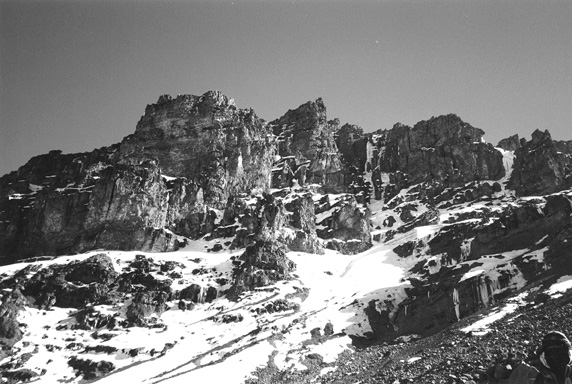
“Any athlete who has ever gone through two-a-day practices gets a glimpse of the effort that goes into something like this and the unspoken bond it forms between team members. We found that testing ourselves to the limit was both liberating and soulful."
Photo by Bruce Polizotto
Magazine
Winter/Spring 2002
 A
tale of two mountains
A
tale of two mountains
Tanzania’s Mt. Kilimanjaro subjects trekkers to one of the most
arduous hikes on the planet. From the 5,000 ft. elevation base camp to
19,340 ft. Uhura Point at the crater’s rim, you trudge more than
70 miles—the first 40 at a constant 30¾ grade through rainforest,
savannah, and high desert before you even reach the base of the dormant
volcano you’ve seen in photos. Then you scramble over endless fields
of boulders momentarily frozen in ice at oxygen-starved elevations and
pray you don’t get a cerebral edema. The final 900 feet are nearly
vertical above the crater floor, an ascent that takes nearly three hours
and offers a view of the Great Rift Valley, the possible birthplace of
mankind and site of the Leakey’s anthropological research.
On average, 10 climbers die on Kilimanjaro each year. The tallest free-standing
mountain in the world is one of the “Seven Summits”—the
pantheon of mountaineer lore. But many technical mountaineers avoid “the
mountain of the gods.” The adrenalin-driven find ascending Africa’s
highest mountain not worth those risks or the grueling, six-to-eight-day
effort required.
That effort is singed into the lungs and memory of Wabash Trustee Bruce
Polizotto ’63. In October of 1999, he joined nine men, aged 45 to
60, for what the trip’s organizer advertised as “a grand adventure.”
Before the trek ended, two men would be carried off the mountain, most
would become painfully ill at high altitude, and all faced obstacles,
physical and emotional, they had never imagined.
Spending a restless final night on the crater floor as a fellow team
member howled in pain with what was later diagnosed as a pulmonary edema,
Polizotto gave up on sleep and stepped out of his two-man tent to find
that anabatic breezes had swept the early evening clouds. A star-strewn
sky was within reach, as if you could climb a few feet higher and touch
the Southern Cross.
“With no background light, and such clear air at this elevation,
there were so many stars, and the light so sharp and clear. It really
was wondrous—no camera could capture it.”
But when friends ask Polizotto to recall his most memorable image from
those ten days, he answers: “the back of the boot of the guy in front
of me.” That’s not just a glib response.
His comrades on the trail were “a blessing;” their conversation
or steady footfalls kept his mind on the task at hand and the person moving
ahead of him. That attention to one another would save a life on the group’s
next adventure.
For although they left Kilimanjaro pledging they’d “never do
that again,” a year and a half later the friends gathered at another
trail, this one in the Andes. The three-day trek up the Inca Trail to
the Sun Gate at Machu Pichu in Peru was shorter, at lower elevation, (14,000
ft.), warmer, and rich in flora, fauna, and history, with Spanish culture
literally layered atop the Inca foundation. Polizotto was amazed to see
Andean condors—with their 12-foot wingspans, the largest flying land
bird on earth—riding thermals over the mountains.
But the trail itself was more harrowing than Kilimanjaro
“It’s like being on a Stairmaster for eight hours a day, and
the drop-off made it like walking along the ledge of a skyscraper without
a rope.”
For those unaccustomed to the trail and the altitude, every step brought
risk. The odds caught up with the group during their descent.
“There was no reference point to follow—you just looked into
the air, or down at the pack in front of you. When we were hiking down
from the Sun Gate at Machu Pichu, one of our hikers lost his footing.
He was teetering over the edge when another on our team grabbed his pack
and pulled him back in. He probably wouldn’t have survived that fall.”
“Any athlete who has ever gone through two-a-day practices gets a
glimpse of the effort that goes into something like this and the unspoken
bond it forms between team members,” Polizotto says. "We found
that testing ourselves to the limit was both liberating and soulful."
Return to the table of contents
